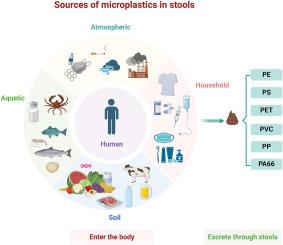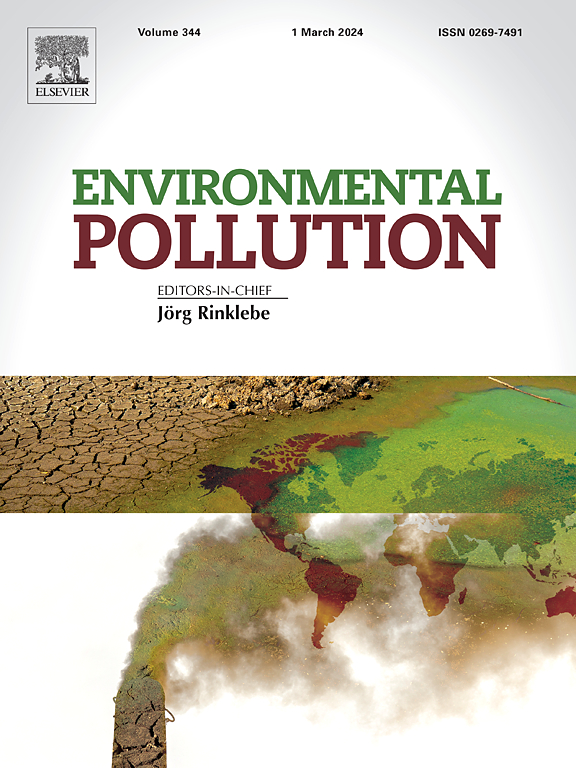Microplastics in stools and their influencing factors among young adults from three cities in China: A multicenter cross-sectional study
IF 7.3
2区 环境科学与生态学
Q1 ENVIRONMENTAL SCIENCES
引用次数: 0
Abstract
The mass concentration of microplastics in stools and influencing factors remain unclear. The aim was to investigate the types and mass concentrations of microplastics in the stools of young college students and to explore potential influencing factors. Twenty-six participants were recruited from colleges in each city using stratified simple sampling, including Changsha, Shanghai, and Changchun. Participants’ dietary and fluid intake behavior was recorded using the 3-day 24-h dietary questionnaire and the 7-day 24-h fluid intake record, respectively. Lifestyle factor information related to microplastic exposure was collected through a microplastic exposure questionnaire. Stools were collected and detected using pyrolysis gas chromatography–mass spectrometry (Py-GCMS) method. Eventually, 78 participants completed the study. The detection rate of microplastics, including polyethylene (PE), polyvinyl chloride (PVC), polystyrene (PS), polypropylene (PP) and polyethylene terephthalate (PET), in stools was 98.7%, with a total mass concentration of 54.7 (10.1–102.7) μg/g. There were differences in the total mass concentrations of microplastics in the stools of participants in three cities, namely Changsha, Shanghai, and Changchun, which decreased sequentially (χ2 = 47.819, P < 0.05). Participants with a relatively high frequency of takeaway food consumption had higher total mass concentrations of microplastics mass concentrations in stools (χ2 = 7.390, P < 0.05). Participants with a relatively high frequency of consuming reheated food had a greater mass concentration of PET microplastics (χ2 = 6.117, P < 0.05). The total mass concentration of microplastics, as well as the mass concentrations of PE, PVC, PP, and PA66, in the bottled water intake group were greater than those in the nonintake group (all P < 0.05). Overall, the total mass concentration of microplastics in stools was related to residential city, consumption of reheated food, and bottled water intake (all P < 0.05). Young college students generally experience microplastic exposure, with the main types being PE, PVC, PS, PP, PET, and PA66. Living location, reheated food consumption, and bottled water intake were factors influencing microplastic exposure.


中国三个城市青壮年粪便中的微塑料及其影响因素:一项多中心横断面研究
粪便中微塑料的质量浓度及其影响因素仍不清楚。本研究旨在调查青年大学生粪便中微塑料的种类和质量浓度,并探讨潜在的影响因素。研究采用分层简单抽样法,从长沙、上海和长春等城市的高校各招募了26名参与者。参与者的饮食和液体摄入行为分别通过 3 天 24 小时饮食问卷和 7 天 24 小时液体摄入记录进行记录。通过微塑料暴露调查问卷收集与微塑料暴露相关的生活方式因素信息。收集粪便并采用热解气相色谱-质谱法(Py-GCMS)进行检测。最终,78 名参与者完成了研究。粪便中聚乙烯(PE)、聚氯乙烯(PVC)、聚苯乙烯(PS)、聚丙烯(PP)和聚对苯二甲酸乙二醇酯(PET)等微塑料的检出率为 98.7%,总质量浓度为 54.7 (10.1-102.7) μg/g。长沙、上海和长春三个城市参与者粪便中微塑料的总质量浓度存在差异,且依次下降(χ2=47.819,P<0.05)。外卖消费频率相对较高的参与者粪便中微塑料的总质量浓度更高(χ2=7.390,P<0.05)。食用加热食物频率相对较高的参与者,其 PET 微塑料的质量浓度更高(χ2=6.117,P<0.05)。瓶装水摄入组的微塑料总质量浓度以及PE、PVC、PP和PA66的质量浓度均高于非摄入组(均为P<0.05)。总体而言,粪便中微塑料的总质量浓度与居住城市、加热食物的消费量和瓶装水的摄入量有关(均为P<0.05)。青年大学生普遍接触过微塑料,主要类型有 PE、PVC、PS、PP、PET 和 PA66。生活地点、热食摄入量和瓶装水摄入量是影响微塑料暴露的因素。
本文章由计算机程序翻译,如有差异,请以英文原文为准。
求助全文
约1分钟内获得全文
求助全文
来源期刊

Environmental Pollution
环境科学-环境科学
CiteScore
16.00
自引率
6.70%
发文量
2082
审稿时长
2.9 months
期刊介绍:
Environmental Pollution is an international peer-reviewed journal that publishes high-quality research papers and review articles covering all aspects of environmental pollution and its impacts on ecosystems and human health.
Subject areas include, but are not limited to:
• Sources and occurrences of pollutants that are clearly defined and measured in environmental compartments, food and food-related items, and human bodies;
• Interlinks between contaminant exposure and biological, ecological, and human health effects, including those of climate change;
• Contaminants of emerging concerns (including but not limited to antibiotic resistant microorganisms or genes, microplastics/nanoplastics, electronic wastes, light, and noise) and/or their biological, ecological, or human health effects;
• Laboratory and field studies on the remediation/mitigation of environmental pollution via new techniques and with clear links to biological, ecological, or human health effects;
• Modeling of pollution processes, patterns, or trends that is of clear environmental and/or human health interest;
• New techniques that measure and examine environmental occurrences, transport, behavior, and effects of pollutants within the environment or the laboratory, provided that they can be clearly used to address problems within regional or global environmental compartments.
 求助内容:
求助内容: 应助结果提醒方式:
应助结果提醒方式:


